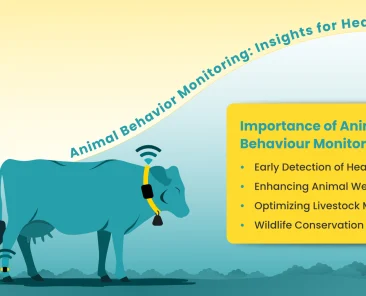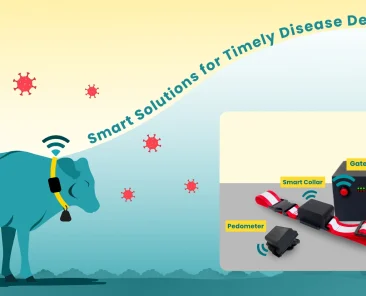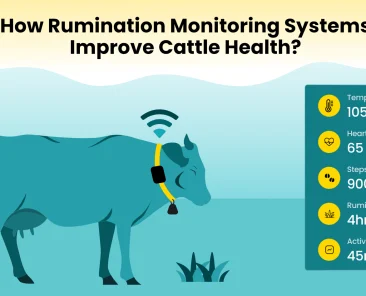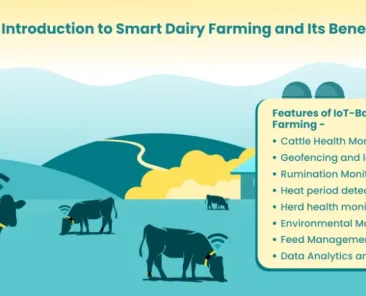Animals can’t tell us when they feel unwell or stressed out, but they show the signs of illness through their behavior, just like humans. That’s what makes animal behaviour monitoring…
- Home
- Cow Health Monitoring
- How Rumination Monitoring Systems Improve Cattle Health?
How Rumination Monitoring Systems Improve Cattle Health?
- Categories: Cow Health Monitoring
Get in Touch
Related Blogs
Taking care of cattle health is important for any farm’s success. However, diseases like foot-and-mouth, mastitis, and tuberculosis can seriously affect the animals and productivity. Disease detection in cattle is…
The use of smart technology has transformed the management of animal health. Farmers can keep an eye on animal activity in real-time with livestock monitoring, especially through rumination tracking, which…
Dairy farming is an important aspect of agriculture, and “smart dairy farming” might sound like an oxymoron, but it is a reality now. Large dairy farms with more than 100…
The use of smart technology has transformed the management of animal health. Farmers can keep an eye on animal activity in real-time with livestock monitoring, especially through rumination tracking, which improves herd management and animal welfare.
Farmers can enhance reproductive success, optimize feeding methods and identify health issues early with IoT-based devices like rumination collars.
Traditional farming practices are being transformed by this technology, which increases operational efficiency and proactivity.
In this article, We will learn about the main advantages of rumination monitoring for livestock management as well as how it is changing the farming sector.
What is Rumination Monitoring in Cattles?
Rumination process in cows refers to the process of tracking the rumination behavior of animals, especially cows. Rumination is a multistep process that begins when cows chew their food and swallow it, then regurgitate it to chew it again.
This behaviour plays a crucial role in the digestive process and helps in breaking down food for better nutrient absorption.
Why is Rumination Monitoring Crucial?
For digestion and overall cattle health monitoring , the rumination process is crucial. Any changes in the amount of time or duration of rumination may be a sign of possible issues. For example, reduced rumination could be an indication of discomfort, disease and malnutrition.
Farmers may reduce the risk of disease outbreaks and improve herd management by quickly recognizing health issues and taking preventive or corrective action by using rumination collars for cattle to track rumination behaviors in real time.
Detailed Working Process of Rumination Tracking In Cows?
Farmers use a combination of software and hardware technologies to monitor animal behavior and track the rumination process step by step. This allows them to gain insights into the cow’s health by observing each stage from chewing to regurgitation and re-chewing.
- Smart Collar: Smart collars are wearable electronics with sensors that can identify vibrations and movements. The purpose of this smart collar is to track the cows head movement while it ruminates. The data captured by these collars is transmitted to the central systems.
- Pedometer: By monitoring these animal movements, these devices give more specific information about the cow’s movement level. Pedometers alert farmers about when an animal shows symptoms of distress, decreased activity, and an unusual pattern of rumination.
- Gateway: This is the central point for communication that gets information from the pedometer and smart collars. It transfers the gathered information to a local or cloud-based database for processing and analysis to produce useful insights.
Benefits of Rumination Monitoring
Rumination monitoring helps farmers detect early signs of disease, heat, and nutritional issues by tracking changes in rumination patterns are as follows:

Disease Detection
Observing rumination can assist in early disease detection in cattle. Farmers can address health issues before they get worse because changes in the length of rumination frequently take place before exterior symptoms of the disease occur. For example, a decrease in rumination could be a sign of metabolic abnormalities, infections or digestive issues.
Heat Detection in Cattle
Rumination monitoring can help determine when cows are experiencing heat, or estrus. Among other behavioral changes, cows in heat show less ruminating. By tracking these patterns, farmers can better time insemination, increasing reproductive success.
Optimizing Nutrition and Feeding Practices
Farmers can improve nutrition and feeding methods by analyzing rumination data. A cow’s digestive health and general performance may be improved by adjusting the type or amount of feed given to it if less rumination suggests that the cow isn’t digesting her food correctly.
Monitoring Recovery After Illness
After an illness, rumination patterns can reveal how well an animal is recovering. A slow return to normal rumination times indicates that the animal is regaining its health, while persistent changes may indicate ongoing issues.
Applications of Rumination Monitoring
Rumination monitoring helps with livestock health management by identifying health issues early, optimizing breeding schedules, and improving overall herd efficiency. Some Popular Applications are:
Livestock Health Management
One effective way to protect herd health is rumination monitoring. By keeping track of individual animal behaviour, farmers can identify animals that require attention, track the progression of illnesses, and make informed decisions about veterinary care.
Fertility and Reproductive Management
In addition to detecting heat, rumination monitoring can help farmers optimize their breeding programs. By knowing when a cow is in heat, farmers can better schedule breeding and reduce the chances of missed opportunities, improving the herd’s reproductive efficiency.
Farm-Wide Herd Management
Rumination data collected from multiple cows can be aggregated to give a complete view of the herd’s health. This data can be used to identify trends across the farm by allowing farmers to manage their herds more effectively and take preventive actions to avoid widespread issues.
Conclusion
In conclusion, rumination monitoring through livestock and rumination collars for cattle tracking is transforming cattle management by providing real-time insights into animal health. This technology enables early detection of health issues, optimized feeding practices and improved reproductive success. As it evolves, it will continue to enhance farm productivity and animal welfare. Overall, it offers farmers a proactive and efficient way to manage their herds and ensure long-term sustainability in livestock farming.
FAQs
Why is rumination monitoring important in cattle management?
By tracking changes in the chewing and swallowing habits of cattle, ruminant monitoring supports farmers in identifying early indicators of health problems, such as discomfort or sickness. It makes immediate actions possible, enhancing the management and health of herds.
What types of data does a rumination monitor collect?
Data like cow head movements, regurgitation frequency, and ruminating time are tracked with a rumination monitor. In order to evaluate general health and feeding effectiveness, it may also gather behavioral patterns and activity levels.
Can rumination monitoring detect health issues early?
Yes, changes in rumination patterns can signal health issues like infections or digestive problems before visible symptoms appear. Early detection allows farmers to take proactive measures to prevent more serious conditions.
Get in Touch
Related Blogs
Animals can’t tell us when they feel unwell or stressed out, but they show the signs of illness through their behavior, just like humans. That’s what makes animal behaviour monitoring…
Taking care of cattle health is important for any farm’s success. However, diseases like foot-and-mouth, mastitis, and tuberculosis can seriously affect the animals and productivity. Disease detection in cattle is…
The use of smart technology has transformed the management of animal health. Farmers can keep an eye on animal activity in real-time with livestock monitoring, especially through rumination tracking, which…
Dairy farming is an important aspect of agriculture, and “smart dairy farming” might sound like an oxymoron, but it is a reality now. Large dairy farms with more than 100…




